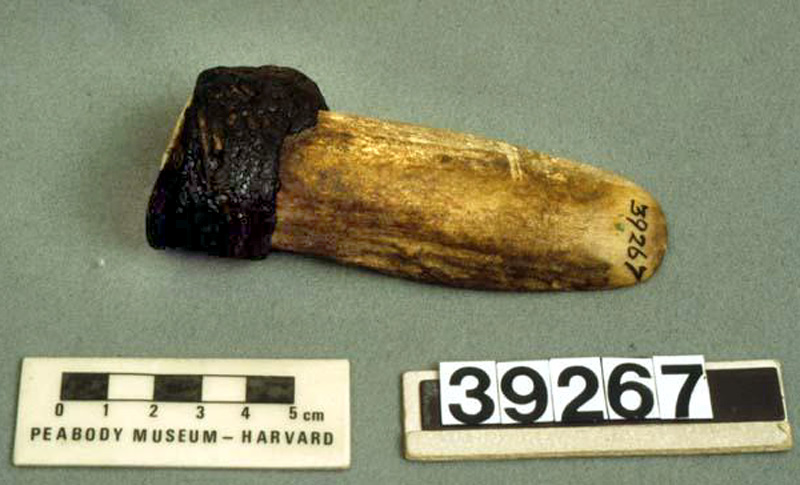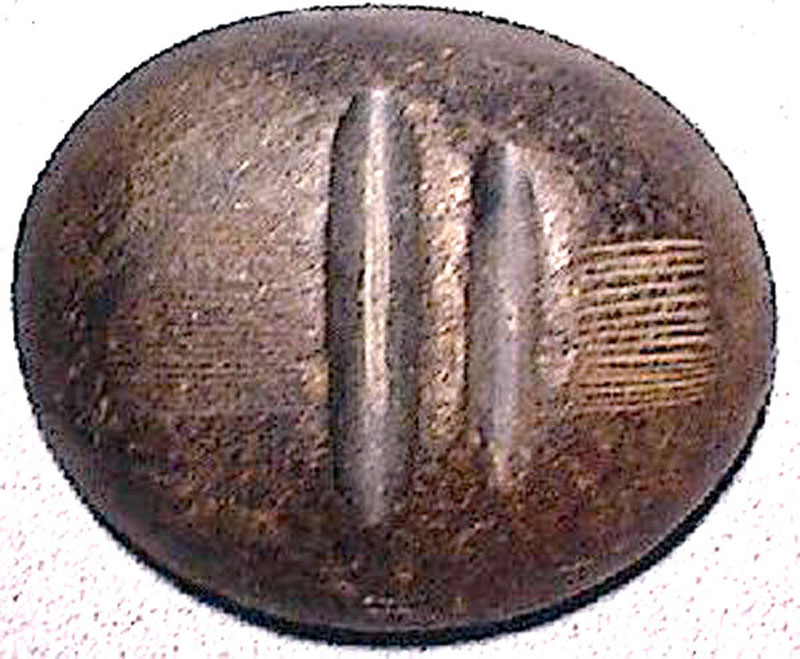|
|
Bowers Cave | Peabody Museum

Antler wedge (a tool) found in Bowers Cave in the San Martin Mountains (present-day Val Verde area) in 1884. In the collection of the Peabody Museum of Archaeology and Ethnology at Harvard University, Cambridge, Mass. Peabody Catalog No. 86-23-10/39267. Antler (elk?) with braided fiber cord that has been impregnated with asphaltum as a bonding material. 4.5 inches long, 1-13/16 inches wide, 1 inch maximum height (the cordage). According to Elsasser and Heizer (1963), four antler specimens were found in Bowers Cave, and of those, this is the only one that was heavily worked. Elsasser and Heizer say one of the others was "crudely chipped" and the remaining two were "simply antler tips, probably deer";they may have been used in chipping or flaking stone. Elsasser and Heizer say the following about No. 39267: The specimen ... had a certain amoung of care expended in its manufacture. The tapered long section and slightly rounded end suggest a wedge. It is 11.5cm long and 33mm wide. A distinct polishing has taken place on about one-half its length on one side and on about 15mm near the tip on the other side, which mostly shows cancellous type tissue. The proximal end of the specimen has a square break which is not polished. At this end there is a wrapping (5 spirals) of Z-twist, 2-ply cordage 4.5mm thick. Oen end and a short length of the cordage have been covered by the spirals, and the other end terminates toward the tip of the bone. The cordage is heavily impregnated with asphaltum which serves also to attach it to the bone. Probably the cordage was used as a sort of handle, but whether or not this was the case, we must again point to a specimen rarely encountered in a southern Californian archaeological context — what at least appears to be a hafted wedge. Harrington (1942) notes the presence of deerhorn wedges among the Chumash of the Central Coast, both northern and southern. Citing Bowers (1885), Elsasser and Heizer say the antler tools "were found during excavation of the infilling of the cave and are therefore probably not associated with the basket cache itself." Indeed, Bowers (1885) suggests the antler tools were not part of what was intended to be hidden away in the cave; rather, they were simply tools that were found on the floor beneath the baskets that contained the important objects. He writes: In excavating the bottom of the cave we found considerable basket work as though it has been covered with this material. A wedge was found made of the base of a deer's antler, 4½ inches long by 1⅜ inches in diameter, wrapped securely at the larger end with some kinds of cord to prevent splitting when in use. Also a haliotis shell, Haliotis cracherodii, having the holes filled with a cord, and used, probably, for a drinking cup. A shell ornament and portions of deer's antlers, and a serpentine implement for smoothing and straightening the tules for their basket work, were also found.
PB39267: 19200 dpi jpeg from smaller jpeg, Peabody Museum. |
Bowers Cave Specimens (Mult.)
Bowers on Bowers Cave 1885
Stephen Bowers Bio
Bowers Cave: Perforated Stones (Henshaw 1887)
Bowers Cave: Van Valkenburgh 1952
• Bowers Cave Inventory (Elsasser & Heizer 1963)
Tony Newhall 1984
• Chiquita Landfill Expansion DEIR 2014: Bowers Cave Discussion
Vasquez Rock Art x8
Ethnobotany of Vasquez, Placerita (Brewer 2014)
Bowl x5
Basketry Fragment
Blum Ranch (Mult.)
Little Rock Creek
Grinding Stone, Chaguayanga
Fish Canyon Bedrock Mortars & Cupules x3
2 Steatite Bowls, Hydraulic Research 1968
Steatite Cup, 1970 Elderberry Canyon Dig x5
Ceremonial Bar, 1970 Elderberry Canyon Dig x4
Projectile Points (4), 1970 Elderberry Canyon Dig
Paradise Ranch Earth Oven
Twined Water Bottle x14
Twined Basketry Fragment
Grinding Stones, Camulos
Arrow Straightener
Pestle
Basketry x2
Coiled Basket 1875
Riverpark, aka River Village (Mult.)
Riverpark Artifact Conveyance
Tesoro (San Francisquito) Bedrock Mortar
Mojave Desert: Burham Canyon Pictographs
Leona Valley Site (Disturbed 2001)
2 Baskets
So. Cal. Basket
Biface, Haskell Canyon
2 Mortars, 2 Pestles, Bouquet Canyon
|
The site owner makes no assertions as to ownership of any original copyrights to digitized images. However, these images are intended for Personal or Research use only. Any other kind of use, including but not limited to commercial or scholarly publication in any medium or format, public exhibition, or use online or in a web site, may be subject to additional restrictions including but not limited to the copyrights held by parties other than the site owner. USERS ARE SOLELY RESPONSIBLE for determining the existence of such rights and for obtaining any permissions and/or paying associated fees necessary for the proposed use.















































